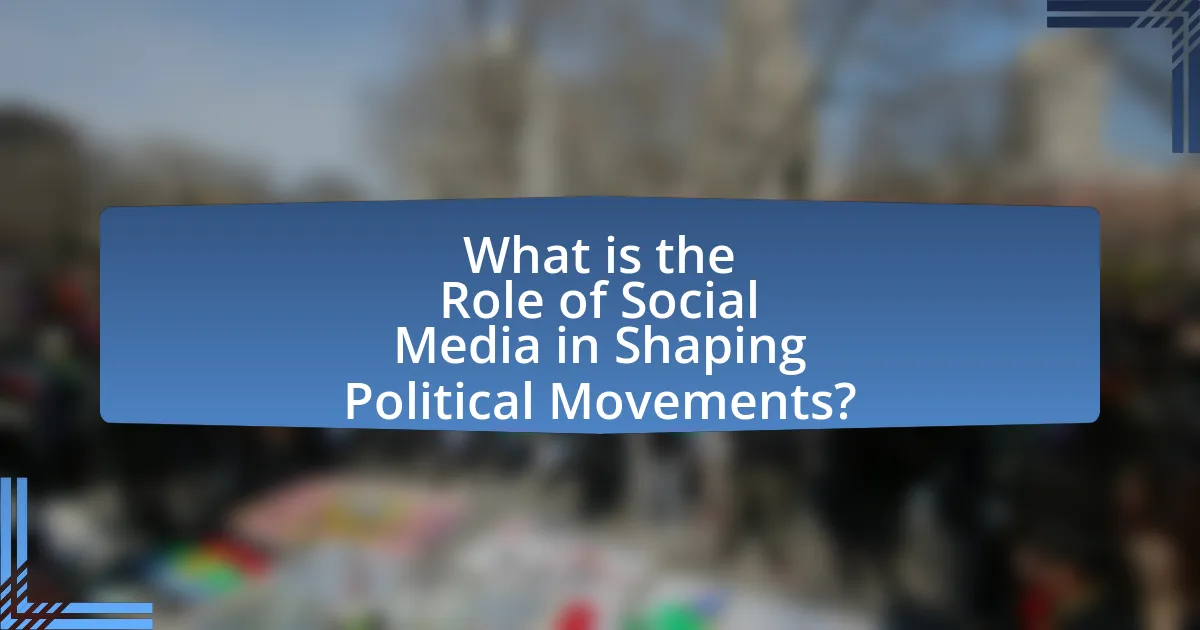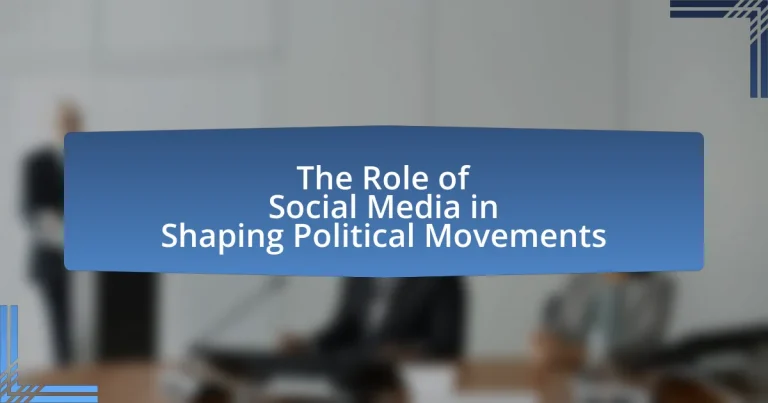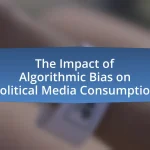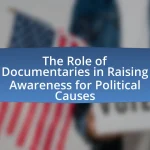The article examines the significant role of social media in shaping political movements, highlighting its impact on communication, mobilization, and public awareness. It discusses how platforms like Twitter, Facebook, and Instagram facilitate rapid information dissemination and grassroots organization, as evidenced by movements such as the Arab Spring and Black Lives Matter. The article also explores demographic differences in social media usage for political purposes, the challenges of misinformation and censorship, and strategies for maximizing engagement and influence. Additionally, it addresses future trends in social media and political activism, emphasizing the importance of effective content creation and community building in driving political change.

What is the Role of Social Media in Shaping Political Movements?
Social media plays a crucial role in shaping political movements by facilitating communication, mobilization, and awareness among activists and the general public. Platforms like Twitter, Facebook, and Instagram enable rapid dissemination of information, allowing movements to gain visibility and support quickly. For instance, the Arab Spring in 2010-2011 demonstrated how social media was instrumental in organizing protests and sharing real-time updates, which contributed to the overthrow of several regimes. Additionally, studies indicate that social media can influence public opinion and political engagement; a Pew Research Center report found that 69% of Americans use social media, with many citing it as a key source for political news. This connectivity fosters a sense of community and shared purpose, essential for the success of political movements.
How has social media transformed political engagement?
Social media has transformed political engagement by enabling direct communication between politicians and the public, facilitating grassroots movements, and increasing political awareness. Platforms like Twitter and Facebook allow politicians to share their messages instantly, bypassing traditional media filters, which enhances transparency and accountability. For instance, during the Arab Spring, social media played a crucial role in mobilizing protests and disseminating information, demonstrating its power in shaping political discourse. Additionally, studies show that social media usage correlates with higher levels of political participation, as users are more likely to engage in discussions, share political content, and participate in civic activities.
What platforms are most influential in political movements?
Social media platforms such as Twitter, Facebook, and Instagram are the most influential in political movements. These platforms facilitate rapid information dissemination, allowing activists to mobilize support and organize events effectively. For instance, Twitter played a crucial role during the Arab Spring, enabling real-time communication and coordination among protesters. Facebook’s ability to create event pages and groups has been instrumental in organizing large-scale demonstrations, as seen in the Black Lives Matter movement. Instagram’s visual storytelling capabilities have also been pivotal in raising awareness and engaging younger audiences in political issues.
How do different demographics use social media for political purposes?
Different demographics utilize social media for political purposes in distinct ways, influenced by factors such as age, race, and socioeconomic status. For instance, younger individuals, particularly those aged 18-29, predominantly use platforms like Instagram and TikTok to engage with political content, often sharing memes and videos that resonate with their peers, as evidenced by a Pew Research Center study indicating that 71% of this age group uses social media for political engagement. In contrast, older demographics, such as those aged 50 and above, tend to favor Facebook for political discussions and news consumption, reflecting a preference for more traditional forms of communication. Additionally, racial and ethnic minorities often leverage social media to mobilize and advocate for social justice issues, with studies showing that Black and Hispanic users are more likely to use platforms for activism compared to their white counterparts. This varied usage highlights how different demographic groups adapt social media to their political needs and contexts.
Why is social media important for grassroots movements?
Social media is important for grassroots movements because it enables rapid communication and mobilization among supporters. This platform allows grassroots organizations to disseminate information quickly, engage with a wider audience, and coordinate actions effectively. For instance, during the Arab Spring, social media played a crucial role in organizing protests and sharing real-time updates, which significantly contributed to the movements’ visibility and impact. Additionally, studies have shown that social media can increase participation rates in grassroots campaigns by providing a space for dialogue and community building, thus enhancing the overall effectiveness of these movements.
What advantages does social media provide to grassroots organizers?
Social media provides grassroots organizers with enhanced communication, broader reach, and increased engagement. These platforms allow organizers to disseminate information quickly and efficiently, reaching diverse audiences without the constraints of traditional media. For instance, a study by the Pew Research Center found that 69% of adults in the U.S. use social media, enabling organizers to tap into a vast network for mobilization and awareness campaigns. Additionally, social media facilitates real-time interaction, allowing grassroots movements to respond to events and engage supporters instantly, which is crucial for maintaining momentum in political movements.
How does social media facilitate community building in political movements?
Social media facilitates community building in political movements by providing platforms for communication, organization, and mobilization among like-minded individuals. These platforms enable users to share information rapidly, coordinate events, and foster a sense of belonging through shared goals and values. For instance, during the Arab Spring, social media was instrumental in organizing protests and disseminating information, which helped unite diverse groups under a common cause. Research by the Pew Research Center indicates that 69% of adults in the U.S. use social media, highlighting its widespread reach and potential to connect individuals across geographical boundaries, thus enhancing community engagement in political activism.
What challenges do political movements face on social media?
Political movements face significant challenges on social media, including misinformation, algorithmic bias, and platform censorship. Misinformation can spread rapidly, undermining the credibility of movements and creating confusion among supporters. For instance, during the 2020 U.S. elections, false narratives circulated widely, impacting public perception and engagement. Algorithmic bias can limit the visibility of political content, as platforms prioritize certain types of posts over others, potentially marginalizing less mainstream movements. Additionally, platform censorship can lead to the removal of content deemed inappropriate or harmful, which can stifle free expression and hinder the ability of movements to mobilize support. These challenges collectively complicate the efforts of political movements to effectively communicate their messages and engage with their audiences.
How do misinformation and disinformation impact political movements?
Misinformation and disinformation significantly undermine political movements by distorting public perception and eroding trust in institutions. These false narratives can mobilize or demobilize supporters, as seen in the 2016 U.S. presidential election, where misleading information spread through social media influenced voter behavior and opinions. Research by the Pew Research Center indicates that 64% of Americans believe fabricated news stories cause confusion about basic facts, which can lead to polarization and hinder constructive political discourse. Furthermore, disinformation campaigns, such as those attributed to foreign interference, have been shown to exploit social media algorithms to amplify divisive content, thereby impacting the trajectory and effectiveness of political movements.
What are the risks of censorship and platform policies for activists?
Censorship and platform policies pose significant risks for activists by limiting their ability to communicate and organize effectively. These restrictions can lead to the suppression of critical information, hindering activists’ efforts to mobilize support and raise awareness about social issues. For instance, platforms like Facebook and Twitter have faced criticism for removing content related to protests or political dissent, which can isolate activists from their audiences and diminish their impact. A study by the Electronic Frontier Foundation highlights that over 70% of activists reported experiencing some form of censorship on social media, illustrating the pervasive nature of this issue. Additionally, algorithmic biases can further marginalize activist voices, as content that challenges the status quo may be deprioritized, reducing visibility and engagement.
How do social media campaigns influence public opinion?
Social media campaigns influence public opinion by rapidly disseminating information and shaping narratives through targeted messaging. These campaigns utilize algorithms to reach specific demographics, amplifying particular viewpoints and mobilizing support for political movements. For instance, a study by the Pew Research Center found that 64% of Americans believe social media has a significant impact on their political views, highlighting its role in shaping public discourse. Additionally, social media platforms enable real-time engagement, allowing users to interact with content and each other, which can reinforce or challenge existing beliefs. This dynamic interaction further solidifies the influence of social media campaigns on public opinion.
What strategies can political movements use to maximize social media impact?
Political movements can maximize social media impact by employing targeted messaging, engaging storytelling, and data-driven strategies. Targeted messaging ensures that content resonates with specific demographics, increasing engagement; for instance, the 2016 U.S. presidential campaign utilized Facebook’s ad targeting to reach key voter segments effectively. Engaging storytelling captures attention and fosters emotional connections, as seen in movements like Black Lives Matter, which used personal narratives to highlight systemic injustices. Data-driven strategies involve analyzing social media metrics to refine approaches, allowing movements to adapt in real-time based on audience feedback and engagement levels, exemplified by the use of analytics tools during the Arab Spring to gauge public sentiment and optimize outreach efforts.
How can movements effectively engage their audience on social media?
Movements can effectively engage their audience on social media by utilizing targeted messaging, interactive content, and community building. Targeted messaging ensures that the content resonates with specific demographics, increasing relevance and engagement; for instance, the Black Lives Matter movement has successfully tailored its messages to address issues pertinent to various communities, resulting in widespread support and participation. Interactive content, such as polls, live Q&A sessions, and user-generated content, fosters a sense of involvement and investment among followers, as seen in the Ice Bucket Challenge, which encouraged participation and virality. Additionally, community building through consistent communication and support networks enhances loyalty and mobilization, exemplified by the way the Arab Spring utilized social media to create solidarity among activists. These strategies collectively enhance audience engagement and amplify the movement’s impact.
What role does content creation play in social media strategies?
Content creation is essential in social media strategies as it drives engagement, shapes brand identity, and influences audience perception. High-quality, relevant content attracts users, encourages sharing, and fosters community interaction, which is crucial for political movements seeking to mobilize support. For instance, a study by the Pew Research Center found that 69% of adults in the U.S. use social media, highlighting its role as a primary platform for information dissemination and community building. This engagement through content can significantly impact political discourse and voter mobilization, demonstrating the strategic importance of effective content creation in social media.
What are the future trends of social media in political movements?
The future trends of social media in political movements will increasingly focus on the use of artificial intelligence and data analytics to target specific voter demographics. As political campaigns leverage advanced algorithms, they will enhance their ability to tailor messages and mobilize supporters effectively. For instance, the 2020 U.S. presidential election demonstrated how data-driven strategies could influence voter turnout and engagement through platforms like Facebook and Twitter. Additionally, the rise of decentralized social media platforms may provide alternative spaces for political discourse, reducing the influence of major corporations and enhancing user privacy. This shift could lead to more grassroots movements gaining traction, as seen in recent protests globally that utilized platforms like TikTok to organize and spread awareness rapidly.
How might emerging technologies change the landscape of political activism?
Emerging technologies are likely to transform political activism by enhancing communication, mobilization, and engagement among activists. For instance, social media platforms like Twitter and Facebook have already enabled rapid dissemination of information, allowing movements to gain traction quickly, as seen in the Arab Spring where social media played a crucial role in organizing protests. Additionally, technologies such as blockchain can provide transparency in funding and decision-making processes, fostering trust within activist groups. Furthermore, data analytics can help identify and target specific demographics, increasing the effectiveness of campaigns. These advancements illustrate how emerging technologies are reshaping the strategies and dynamics of political activism.
What lessons can be learned from past political movements on social media?
Past political movements on social media demonstrate the importance of rapid information dissemination and grassroots mobilization. For instance, the Arab Spring in 2010-2011 showcased how platforms like Twitter and Facebook enabled activists to organize protests and share real-time updates, leading to significant political changes in several countries. Additionally, the Black Lives Matter movement illustrated the power of social media in raising awareness and fostering community engagement around social justice issues, resulting in widespread protests and policy discussions. These examples highlight that effective use of social media can amplify voices, create solidarity, and influence public opinion, ultimately shaping political landscapes.
What best practices should political movements follow on social media?
Political movements should prioritize transparency, engagement, and strategic content sharing on social media. Transparency builds trust; for instance, movements that openly share their goals and funding sources tend to attract more supporters. Engagement is crucial; responding to followers and participating in discussions can enhance community involvement, as seen in the success of the Black Lives Matter movement, which actively interacted with its audience. Additionally, strategic content sharing, including the use of visuals and storytelling, can increase reach and impact; research indicates that posts with images receive 94% more views than text-only posts. By adhering to these best practices, political movements can effectively leverage social media to mobilize support and influence public opinion.


